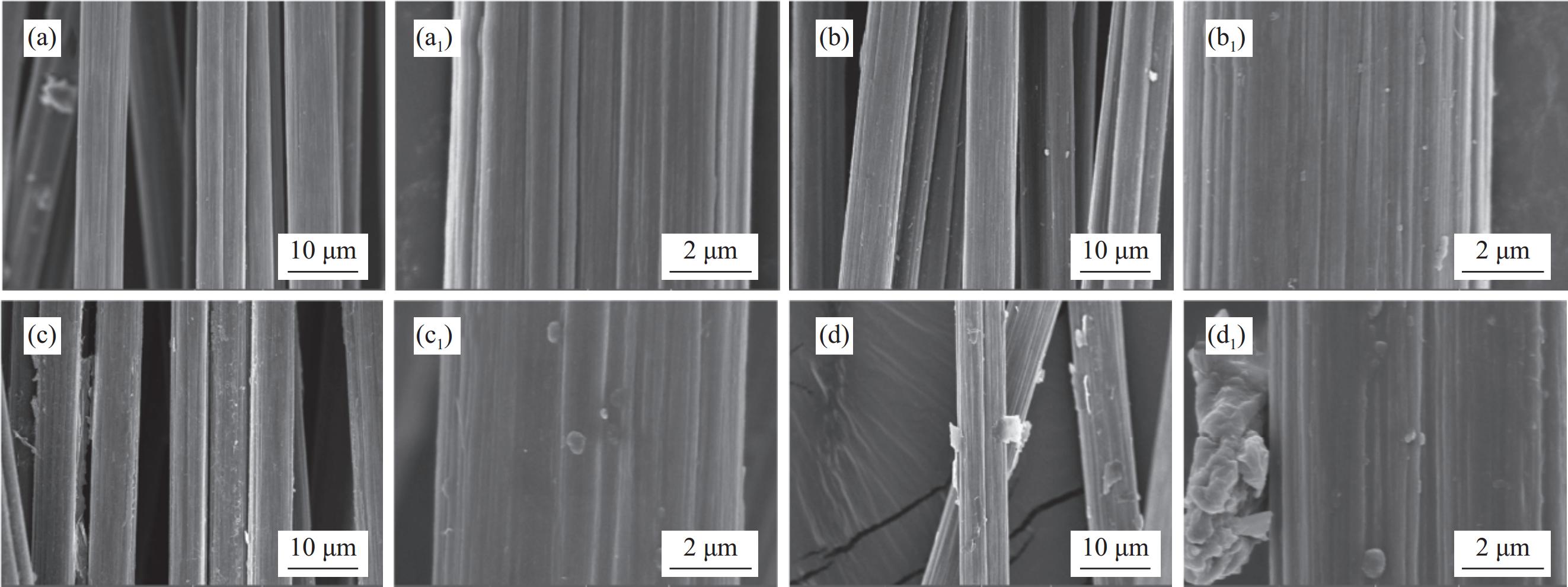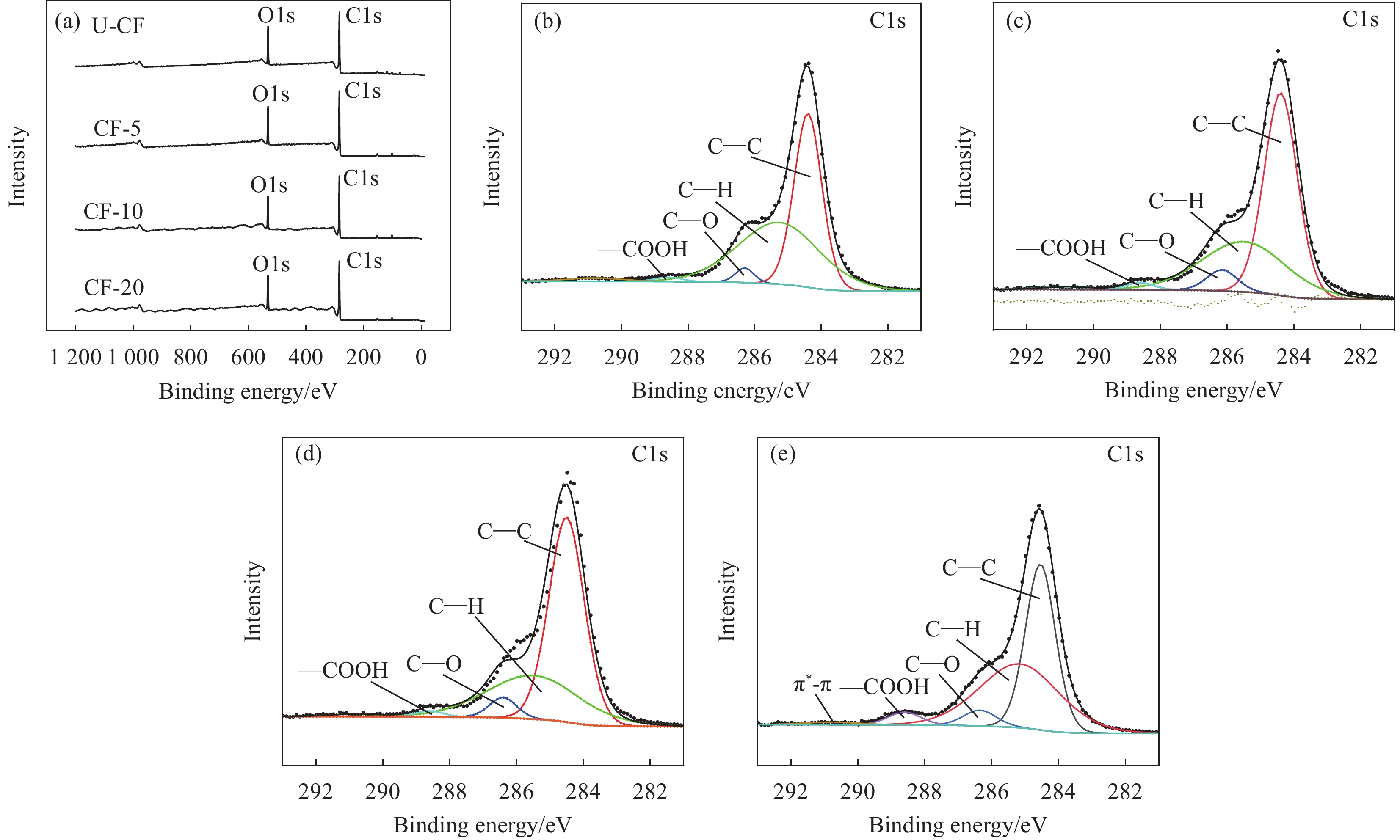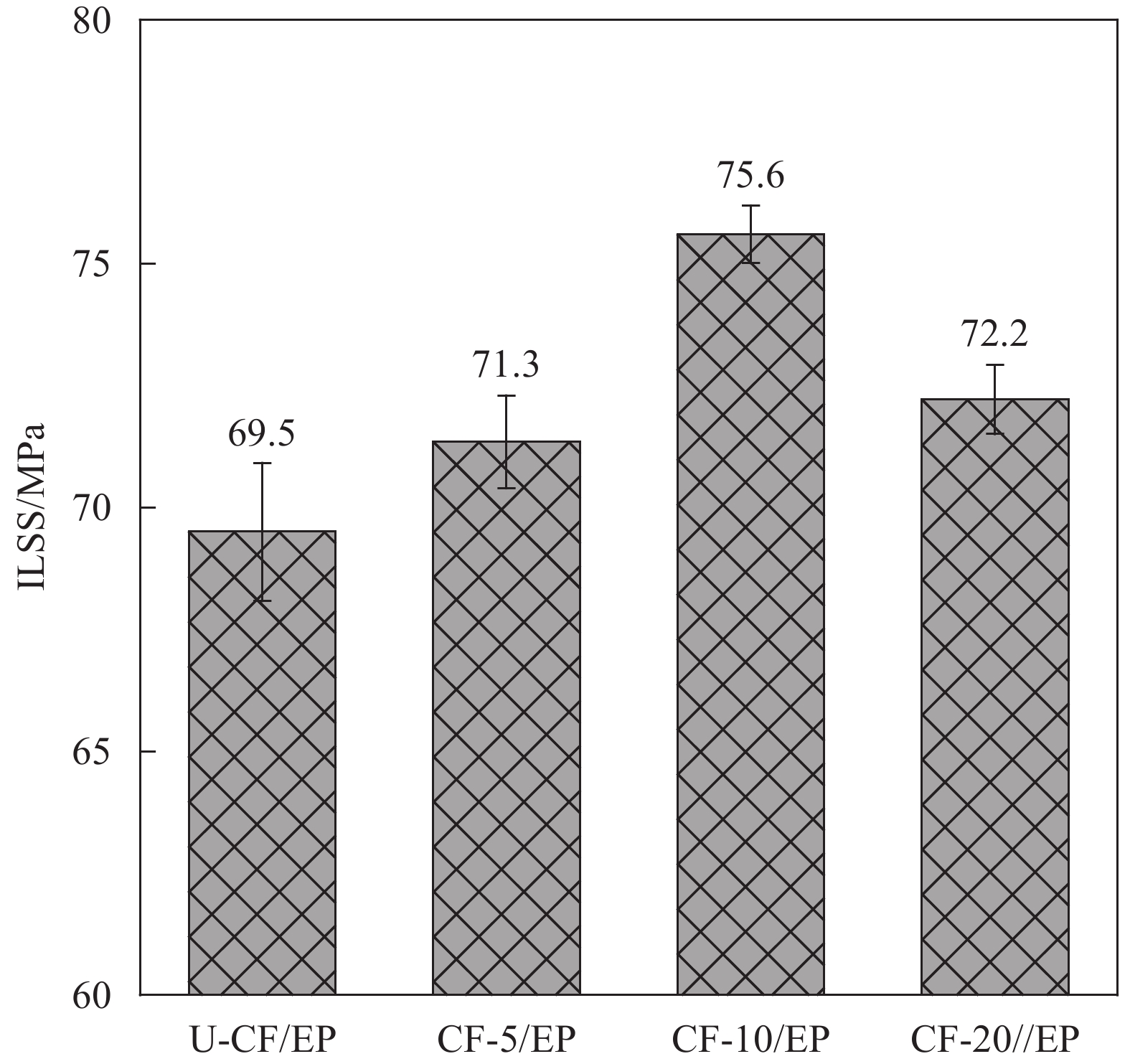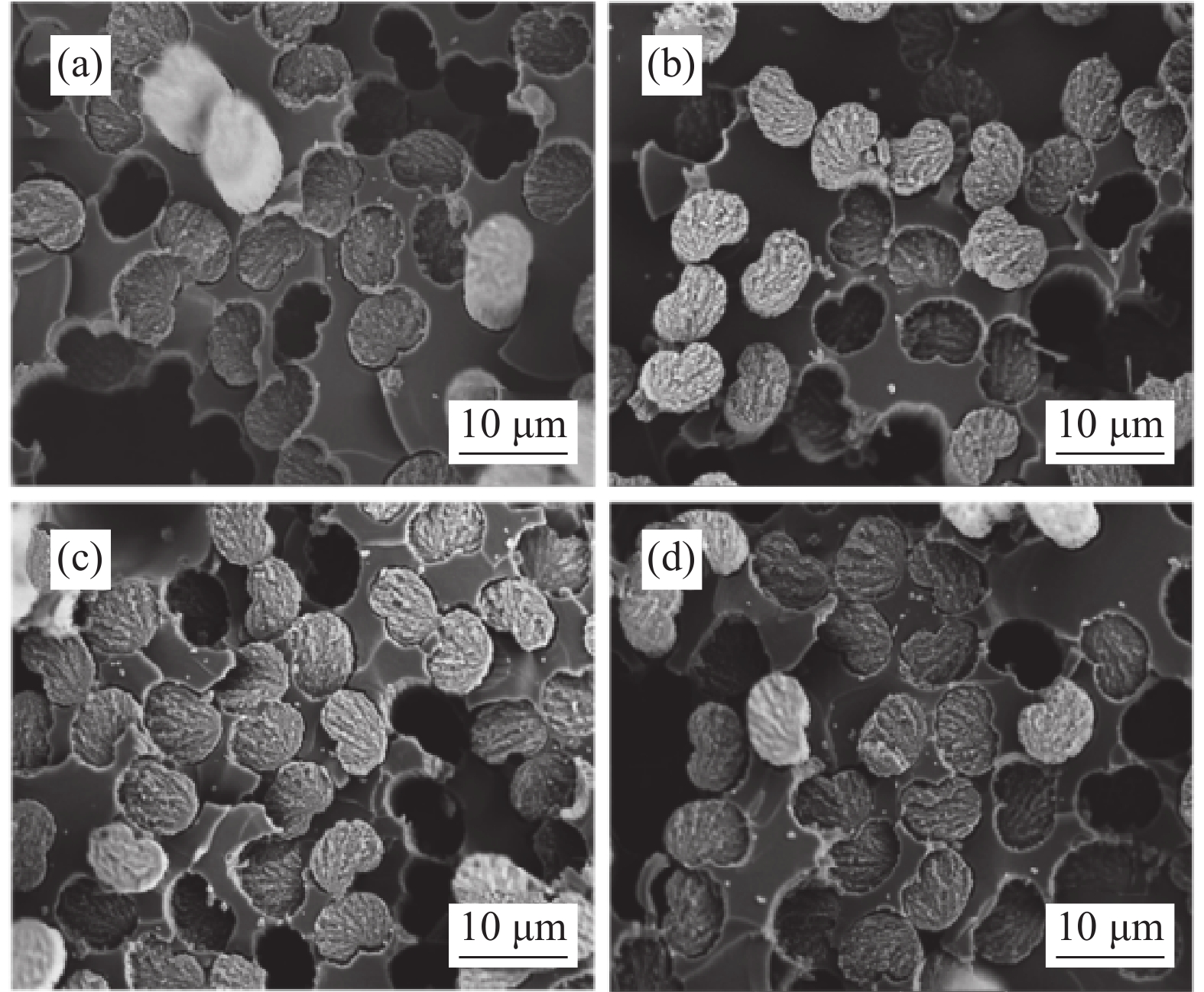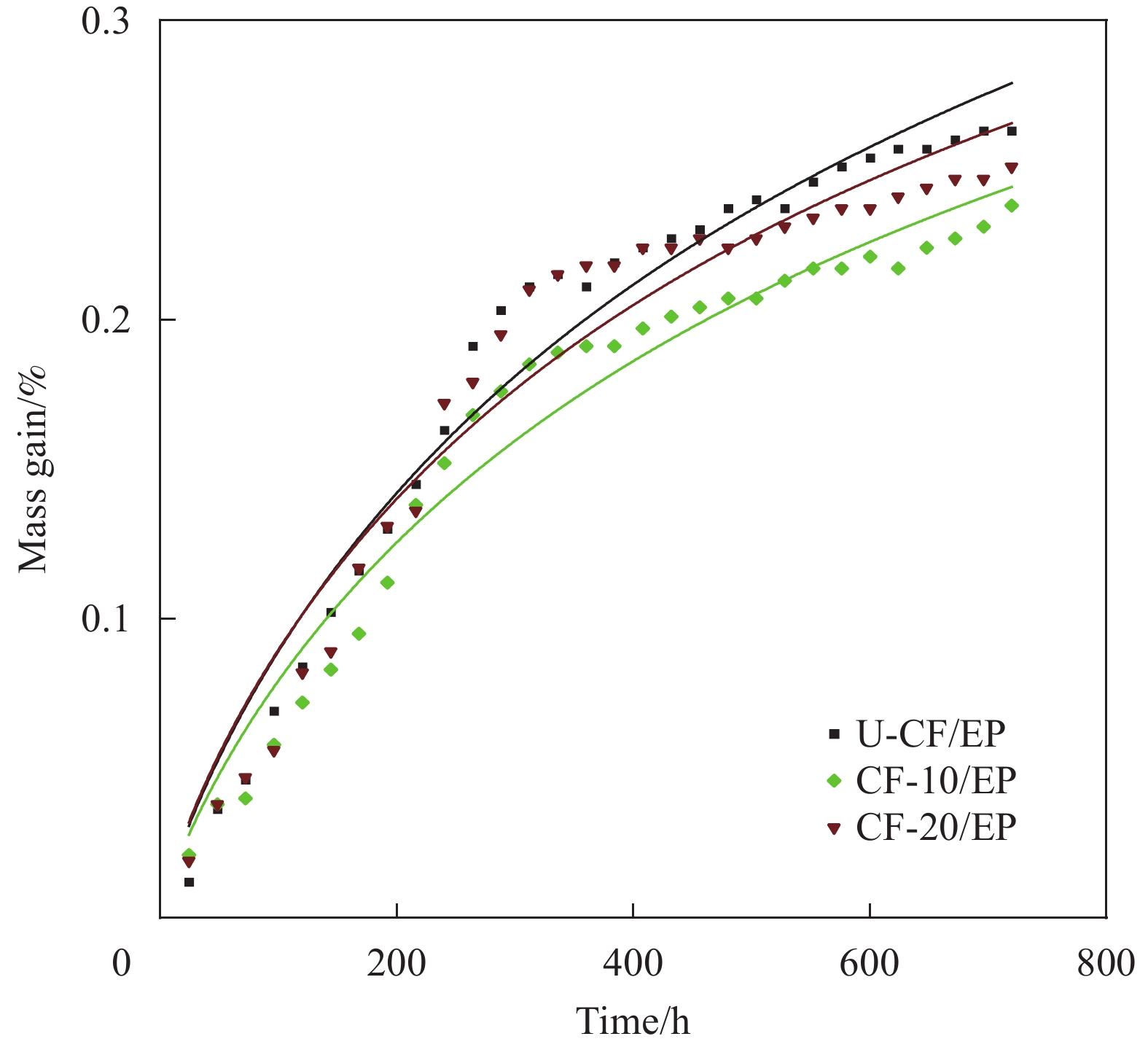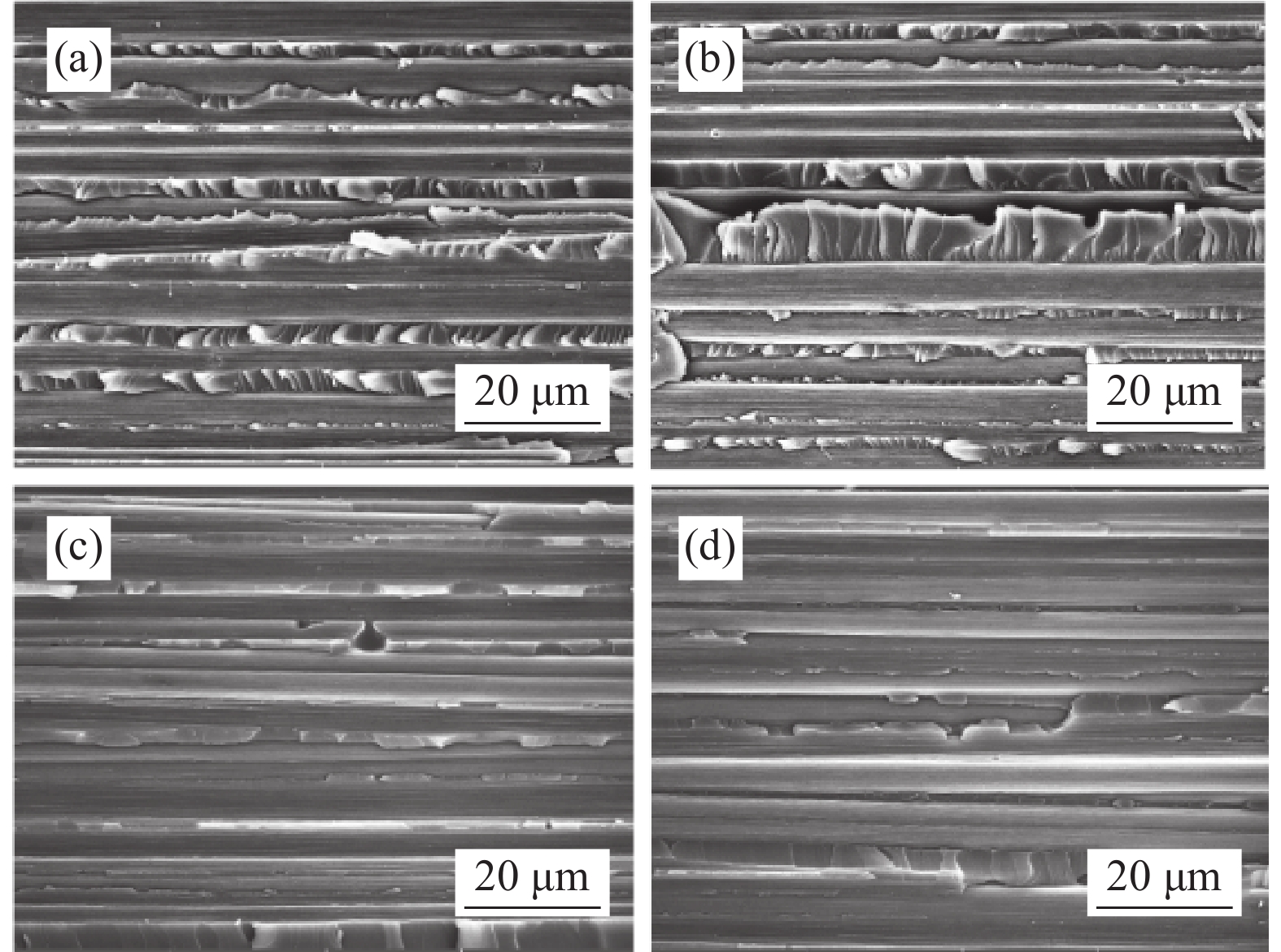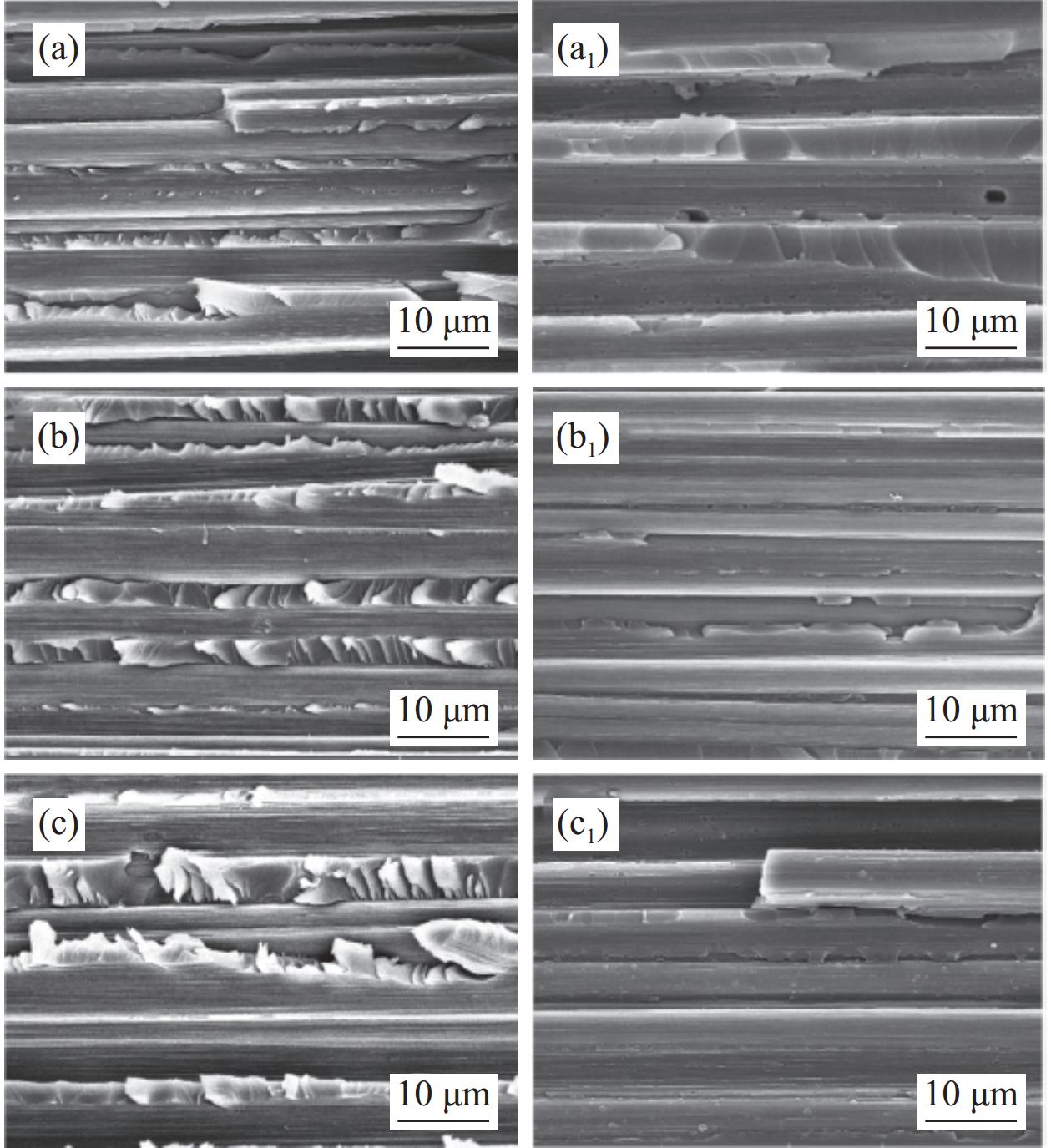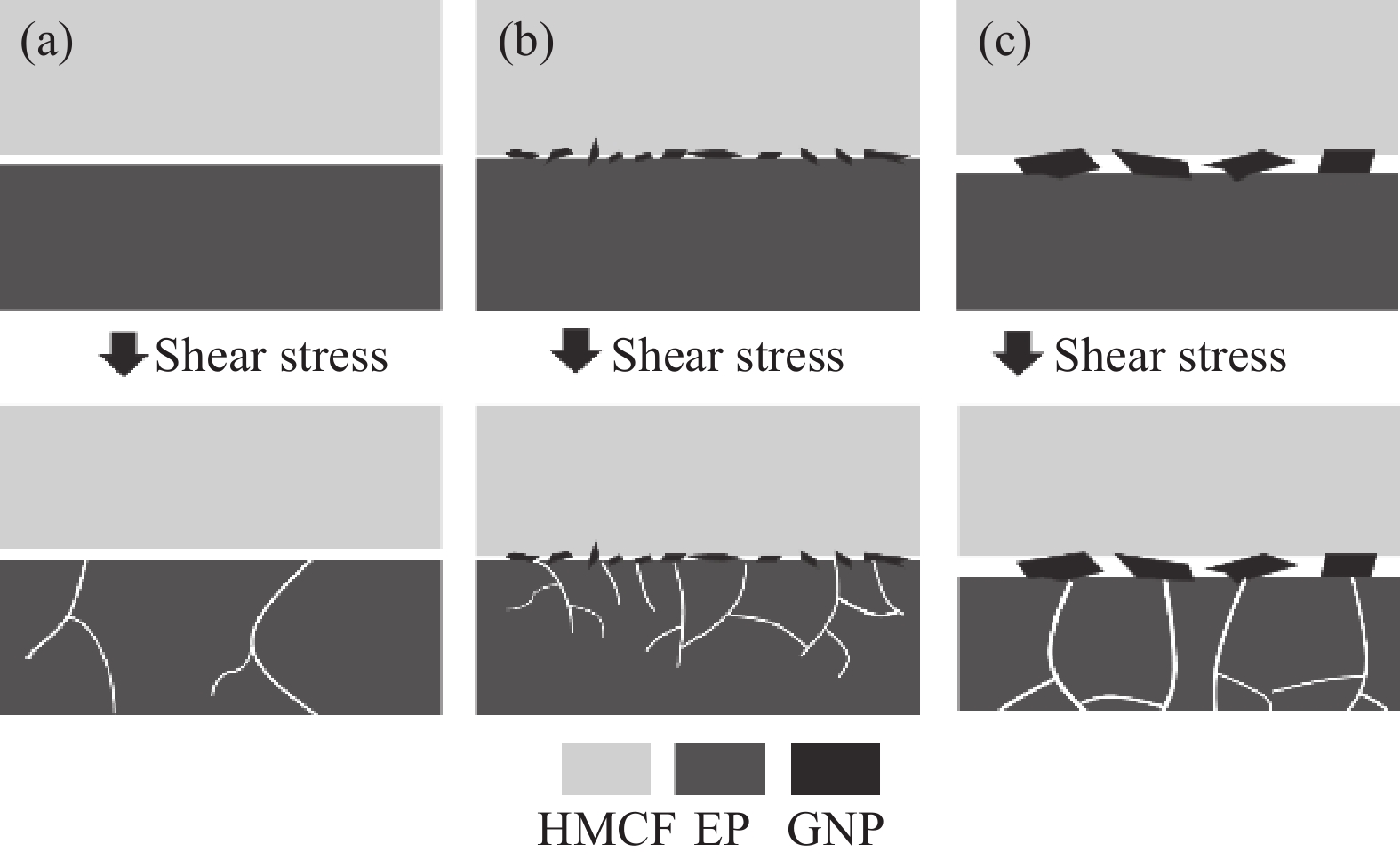Interfacial and hygrothermal properties of high modulus carbon fiber composites modified with graphene nanoplates
-
摘要:
高模量碳纤维(HMCF)复合材料的界面性能一直是影响其应用的关键所在,对HMCF进行表面改性则是实现界面性能提高的重要途径之一。采用电泳沉积法将石墨烯纳米片(GNP)引入到HMCF表面,通过SEM、XPS对改性前后的HMCF表面形貌、表面化学状态进行了表征,测试了改性前后HMCF增强环氧树脂复合材料的层间剪切强度(ILSS)和吸湿率。结果表明,HMCF表面电泳沉积GNP,不仅可以改善其增强环氧树脂复合材料的界面性能,同时也能降低复合材料的吸湿率。在GNP浓度为0.5 mg/mL,电泳沉积电压为10 V时,复合材料层间剪切性能提高了8.8%,达到75.6 MPa;90℃、80%相对湿度(RH)环境下存放30天后,与未改性样品相比,其吸湿率降低了9.5%,存放60天后层间剪切性能仍保持在67.8 MPa。改性高模量碳纤维复合材料界面性能与耐湿热性能均得以提高。
Abstract:The interfacial properties of high-modulus carbon fiber (HMCF) composites have always been the key to their applications, and surface modification of HMCF is one of the important ways to improve the interfacial properties. Graphene nanosheets (GNP) were introduced into the surface of HMCF by electrophoretic deposition, and the surface morphology and surface chemical state of HMCF before and after modification were characterized by SEM and XPS, and the interlaminar shear strength (ILSS) and moisture absorption rate of HMCF reinforced epoxy resin composites before and after modification were tested. The results show that the surface electrophoretic deposition of GNP by HMCF can not only improve the interfacial properties of the reinforced epoxy resin composites, but also reduce the moisture absorption rate of the composites. When the GNP concentration was 0.5 mg/mL and the electrophoretic deposition voltage was 10 V, the interlaminar shear performance of the composites increased by 8.8% to 75.6 MPa, and the moisture absorption rate was reduced by 9.5% compared with the unmodified sample after 30 days of storage at 90℃ and 80% relative humidity (RH), and the interlayer shear performance remained at 67.8 MPa after 60 days of storage. Both interfacial and hygrothermal properties of the modified HMCF comosites have been improved.
-
高模量碳纤维增强环氧树脂基复合材料由于高强度、高比刚度、耐腐蚀性等方面的理想性能在各个领域得到了广泛的应用[1-4]。但高模碳纤维因表面经高温石墨化处理,缺陷减少,含碳量增加,导致纤维表面活性较低并且与树脂基体结合不够良好[5-6]。当高模碳纤维复合材料在湿热环境下使用时这一缺陷可能更加明显。基于水分子的扩散方式以及复合材料吸湿损伤模式,研究人员在不同湿热条件下探索了碳纤维复合材料在湿热环境下的界面性能,均有所下降[7-8]。Dzul-Cervantes等[9]使用聚砜改性环氧树脂基体,并使用硅烷偶联剂3-缩水甘油醚氧基丙基三甲氧基硅烷对碳纤维进行了表面处理,处理后界面剪切强度(IFSS)提高,并且经过25%以及95%相对湿度老化后,发现IFSS保持率良好。Yu等[10]采用三甲氧基硅烷以及碳纳米管对碳纤维表面进行处理,IFSS提升了26.3%,并且在120天的模拟海水浸泡试验后,IFSS下降缓慢。
另一种方法则是采用碳纳米材料例如碳纳米管(CNT)、氧化石墨烯(GO)等对复合材料的界面进行改性,进而提升复合材料性能[11-12]。但对这些纳米粒子进行氧化与功能化处理过程中耗费成本与时间,并且对纳米粒子本体结构造成了损害[13-14],改性后的复合材料在湿热环境下使用表现一般[15]。原因在于功能化纳米粒子表面带有—COOH、 —CONH、—NH2等官能团,水分子在扩散过程中对其更加敏感,这导致了复合材料湿热性能有所下降[16]。与此不同的是,纳米石墨烯片(GNP)作为一种二维结构的纳米粒子,应用在复合材料中可以提升其界面性能,同时降低复合材料在湿热环境下的吸湿率,提高其力学性能[17-18]。Ozge等[19]研究了不同纤维素纳米晶(CNC)/GNP比例改性的纤维,其增强的复合材料层间剪切强度(ILSS)由35.5 MPa提高到45.4 MPa。
基于此,以二维纳米结构、具有片层阻隔效应的GNP为研究对象,利用CNC自身结构特性对GNP进行分散获得电泳液,采用电泳沉积技术对高模量碳纤维(HMCF)进行沉积改性,实现特性表面的构筑。研究了不同构筑条件对纤维表面及其复合材料的界面性能以及高湿热条件下(80%相对湿度、90℃温度) HMCF复合材料吸湿率与界面性能的变化,并对GNP改性高模碳纤维增强复合材料的作用机制进行讨论。
1. 实验部分
1.1 原材料
高模量碳纤维(3 K),密度为1.83 g/cm3,北京化工大学高模量碳纤维研究室;纤维素纳米晶(CNC),长度约为200 nm,外径约为10 nm,上海麦克林生化科技股份有限公司;石墨烯纳米片(GNP),纯度大于99.5%,北京翰隆达科技发展有限公司;环氧树脂(E44),南通星辰合成材料有限公司;固化剂为三乙烯四胺(TETA),上海麦克林生化科技股份有限公司;去离子水为本实验室自制。
1.2 实验过程
1.2.1 GNP电泳液的制备
为了增加GNP在水中的分散性,先在200 mL去离子水加入0.05 g CNC粉末,搅拌15 min。之后缓慢加入0.1 g GNP,搅拌15 min,采用冰水浴超声法对溶液处理2 h,下一步离心处理10 min,得到GNP浓度0.5 mg/mL的电泳液。
1.2.2 GNP改性碳纤维的制备
将550℃脱胶处理的HMCF通过装有GNP的电泳槽,以碳纤维作阳极,不锈钢电泳槽作阴极,固定电压5、10、20 V对碳纤维进行GNP的沉积,随后进行固含量1.0%水性环氧乳液上浆,分别得到GNP改性碳纤维CF-5、CF-10、CF-20。未改性的HMCF为U-CF,见表1。
表 1 各样品缩写命名Table 1. Abbreviations used for various samples preparedSample code Details U-CF Untreated commercial carbon fibers (CF) CF-5 0.5 mg/mL graphene nanoplates solution 5 V voltage electrophoresis deposited modified fibers CF-10 0.5 mg/mL graphene nanoplates solution 10 V voltage electrophoresis deposited modified fibers CF-20 0.5 mg/mL graphene nanoplates solution 20 V voltage electrophoresis deposited modified fibers U-CF/EP Untreated commercial carbon fiber reinforced epoxy (EP) composites CF-5/EP 0.5 mg/mL graphene nanoplates solution 5 V voltage electrophoresis deposited modified fibers reinforced epoxy composites CF-10/EP 0.5 mg/mL graphene nanoplates solution 10 V voltage electrophoresis deposited modified fibers reinforced epoxy composites CF-20/EP 0.5 mg/mL graphene nanoplates solution 20 V voltage electrophoresis deposited modified fibers reinforced epoxy composites Aged U-CF/EP After 30 d of hygrothermal test (90℃, 80% relative humidity (RH)) untreated commercial carbon fibers reinforced epoxy composites Aged CF-5/EP After 30 d of hygrothermal test (90℃, 80% RH) 0.5 mg/mL graphene nanoplates solution 5 V voltage electrophoresis deposited modified fibers reinforced epoxy composites Aged CF-10/EP After 30 d of hygrothermal test (90℃, 80% RH) 0.5 mg/mL graphene nanoplates solution 10 V voltage electrophoresis deposited modified fibers reinforced epoxy composites Aged CF-20/EP After 30 d of hygrothermal test (90℃, 80% RH) 0.5 mg/mL graphene nanoplates solution 20 V voltage electrophoresis deposited modified fibers reinforced epoxy composites 1.2.3 HMCF/EP复合材料的制备
将脱模剂在不锈钢模具表面均匀涂抹,以10∶1的质量比将环氧树脂E44与固化剂TETA混合均匀,得到混合物。将40%体积占比的基体混合物均匀地涂至单向排列体积占比60%的HMCF束丝表面。将HMCF模压料放入加热好的不锈钢模具中,80℃固化2 h,得到复合材料试样U-CF/EP、CF-5/EP、CF-10/EP、CF-20/EP,见表1。
1.2.4 测试与表征
使用SEM (MAIA3,TESCAN,捷克)表征HMCF以及复合材料断面微观形貌,为了避免电荷聚集,对测试的粉末、纤维及块状复合材料进行了喷金处理。使用XPS (Scientific K-Alpha,Thermo,美国)对HMCF表面化学状态进行了分析表征。
参考GB/T 30969—2014[20]方法,使用Instron 3345型万能材料试验机测试复合材料(200 mm×6 mm×2 mm)的ILSS。压头加载速率为2 mm/min,每组至少获得5个有效值。最后根据下式计算ILSS,取平均值。
ILSS=34Fbh (1) 式中:ILSS为复合材料的层间剪切强度;F为样条最大破坏载荷(N);h为试样厚度(mm);b为试样宽度(mm)。
将不同的HMCF/EP复合材料放置在高低温交变湿热试验箱(上海一恒,BPHS型)中,设置温度90℃、相对湿度(RH) 80%的湿热条件环境,湿热时长为
1440 h,每24 h (12 h湿热+12 h室温高湿度80% RH)为一组吸湿率测试周期,测试30个周期(720 h);层间剪切强度测试选择湿热时长为0、240、480、720、1440 h复合材料试样。2. 结果与讨论
2.1 HMCF形貌
图1为不同处理情况下HMCF的表面形貌图。当GNP浓度固定为0.5 mg/mL时,电压在5 V及10 V处理情况下(图1(b)和图1(c)),纤维表面存在很多小尺寸颗粒的GNP粒子,分布较为均匀并且形成了微小凸起结构;电压在20 V的情况下(图1(d)),纤维表面就会出现粒子团聚的现象,表明电压增大会导致沉积粒子过多,电泳液中的GNP堆叠成块状与片状形貌。
2.2 HMCF表面化学状态
为了确定不同HMCF表面化学状态,对处理后不同纤维进行了XPS测试,不同HMCF的XPS广谱以及C1s峰拟合图如图2所示。
表2给出了不同HMCF的C1s特征峰结合能及相对含量信息。可以看到,经电泳沉积处理后HMCF表面C—O含量达到4.65wt%,有小幅提升,同时—COOH含量也有略微增长,达3.78wt%。主要是由于CNC侧端—OH引入,以及电泳沉积过程中碳纤维表面—COOH的形成[21]。
表 2 不同HMCF C1s特征峰结合能及相对含量Table 2. C1s characteristic peak binding energy and relative content of different HMCFFunctional group Binding energy/eV U-CF/wt% CF-5/wt% CF-10/wt% CF-20/wt% C—C 284.4 46.60 48.31 49.36 44.56 C—H 285.2 48.78 46.08 46.59 45.76 C—O 286.3 2.19 2.69 1.35 4.65 C=O 287.3 — — — — COOH 288.6 0.72 1.70 3.79 3.78 2.3 HMCF/EP复合材料界面性能
将不同改性纤维制成碳纤维增强复合材料,测试ILSS,结果如图3所示。在0~10 V电压的电场条件下改性的HMCF,其复合材料ILSS随电泳沉积电场电压增大而升高,经10 V电压电泳沉积GNP的HMCF,ILSS达到最高值75.6 MPa。此后,增大处理电压,所得HMCF复合材料的界面性能呈下降趋势。
为探究GNP电泳沉积不同处理电压处理的HMCF/EP复合材料受到切应力载荷时的界面失效的机制,采用SEM对复合材料样品的横截面形貌进行了扫描,结果如图4所示。
从图中看到,纤维与基体之间的间隙降低,断面表面树脂碎屑增加,表明电泳沉积方式将GNP引入HMCF表面增加了纤维与环氧树脂基体的物理作用。当处理电压为5 V时(图4(b)),基体间裂纹增多。当电压增大到10 V时横截面如图4(c)所示,树脂基体裂纹进一步增加,此时复合材料受载荷时应力传递较好。电压持续增大到20 V时横截面如图4(d)所示,纤维拔出情况增加,说明随着沉积电场电压增大,GNP粒子发生严重的团聚(图1(d)),从而影响了HMCF/EP界面结构,引起ILSS下降。
2.4 HMCF/EP复合材料湿热性能
在温度90℃、相对湿度80%的条件下,各复合材料湿热过程中吸湿率随时间变化如表3所示。
复合材料吸湿的初始阶段可以用菲克扩散定律描述[22]。在第二阶段吸湿速率下降,继续受到湿热因素的影响,采用两阶段扩散模型[23]进行了拟合。复合材料的吸湿率通过式(2)得到,扩散系数D通过式(3)得到,最后经式(4)拟合可得出参数k、M1∞。
Mt=Wt−W0W0 (2) D=π(h4M∞)2(Mt1−Mt2√t1−√t2)2 (3) Mt=M1∞(1+k√t){1−exp[−7.3(Dth2)0.75]} (4) 式中:Mt为t时刻复合材料的吸湿率;Wt为t时刻复合材料试样质量(g);W0为复合材料试样未湿热时质量(g);M∞为复材Fick饱和吸湿率;M1∞为复材Fick第一阶段饱和吸湿率;k为树脂弛豫常数(mm/h1/2);h为试样厚度(mm);D为扩散系数(mm/h)。
表 3 90℃、80% RH湿热条件下HMCF/EP的吸湿率Table 3. Moisture absorption of HMCF/EP at 90℃, 80% RHSample M5 d/% M10 d/% M15 d/% M20 d/% M25 d/% M30 d/% U-CF 0.08 0.16 0.21 0.24 0.25 0.26 CF-10/EP 0.07 0.15 0.19 0.21 0.22 0.24 CF-20/EP 0.08 0.17 0.22 0.22 0.24 0.25 Note: Mx d—Moisture absorption of composite material after x days. 通过运用第一与第二吸湿阶段的曲线切线相交所对应的纵坐标也同样可以获得M1∞[24]。图5为不同复合材料Fick扩散拟合曲线图。
从图中可以看出,复合材料吸湿率随湿热时间增加而增加。湿热初期,复合材料表面的空隙以及基体之间的缺陷及裂纹会加速水分子的扩散。随后基体吸湿接近饱和,逐渐出现树脂弛豫现象[25]。
表4给出了复合材料吸湿过程中的拟合参数。相比U-CF/EP的水分子扩散系数(15.7×10−4 mm/h),CF-10/EP与CF-20/EP的水分子扩散系数分别为14.8×10−4 mm/h与15.1×10−4 mm/h,表明HMCF经GNP表面改性后,界面处的GNP阻碍了水分子扩散。U-CF/EP的Fick第一阶段饱和吸湿率(M1∞)为0.12%,而电泳沉积改性纤维后复材的M1∞无明显变化。经GNP界面改性的纤维复合材料30天所达到的最大吸湿率(M30 d)与k均有所降低,进一步说明,GNP改性HMCF降低了复合材料的吸湿率。复合材料湿热过程中层间剪切强度随时间变化信息如表5所示。
表 4 80% RH、90℃湿热老化HMCF/EP吸湿拟合参数Table 4. Hygroscopic fitting parameters of HMCF/EP for hygrothermal at 90℃, 80% RHD/
(10−4 mm·h−1)M1∞/% M30 d/% k/
(10−2 mm·h−1/2)R2 CF-10/EP 14.82 0.12 0.24 4.43 0.96 CF-20/EP 15.13 0.14 0.25 3.89 0.95 U-CF/EP 15.69 0.12 0.26 5.19 0.97 Notes: D—Diffusion coefficient of water molecules in composites; M1∞—Saturated moisture absorption rate of the first stage of the composite Fick; M30 d—Moisture absorption of composite material after 30 d; k—Constant related to the relaxation of resin structure; R2—Coefficient of determination. 为研究湿热时间对复合材料界面结合的影响,选取代表性样品CF-10/EP,采用SEM手段分别对复合材料湿热不同时长的纵截面进行了表征,如图6所示。可以看出,CF-10/EP复合材料随湿热时间增加,其基体的裂纹数量从密集转为稀疏,裂纹的尺寸降低,说明随着湿热时间的增加,复合材料吸湿率逐步提高,基体产生了更多缺陷,降低了界面结合效果,减弱了复合材料受载荷时的应力传递效率。
表 5 80% RH、90℃下HMCF/EP老化过程中层间剪切强度Table 5. Interlaminar shear strength during HMCF/EP aging at 90℃, 80% RHSample ILSS0 d/
MPaILSS10 d/
MPaILSS20 d/
MPaILSS30 d/
MPaILSS60 d/
MPaU-CF/EP 69.5 68.6 65.4 64.4 61.3 CF-10/EP 75.6 73.2 69.3 69.5 67.8 CF-20/EP 72.2 68.9 68.1 66.7 65.5 Note: ILSSx d—Interlaminar shear strength of composite material after x days. 对U-CF/EP、Aged U-CF/EP、CF-10/EP、Aged CF-10/EP、CF-20/EP和Aged CF-20/EP纵断面进行观察,结果如图7所示。未经湿热试验的U-CF/EP (图7(a))、CF-10/EP (图7(b))与CF-20/EP (图7(c))基体的裂纹密度较高,说明纤维与基体结合较好,应力传递效果良好。经湿热30天后的纵断面,如图7(a1)~7(c1)所示,复合材料中均出现了孔洞,Aged U-CF/EP产生的孔洞主要分布在树脂基体中,尺寸较大,容易产生应力集中现象,此时树脂受湿热耦合作用影响较大。GNP改性复合材料缺陷出现在界面处,此时GNP周围树脂吸湿,缺陷密集且细小。
![]() 图 7 不同HMCF/EP复合材料轴向截面形态SEM图像:(a) U-CF/EP;(a1) Aged U-CF/EP;(b) CF-10/EP;(b1) Aged CF-10/EP;(c) CF-20/EP;(c1) Aged CF-20/EPFigure 7. SEM images of axial cross-section morphology of different HMCF/EP composites: (a) U-CF/EP; (a1) Aged U-CF/EP; (b) CF-10/EP; (b1) Aged CF-10/EP; (c) CF-20/EP; (c1) Aged CF-20/EP
图 7 不同HMCF/EP复合材料轴向截面形态SEM图像:(a) U-CF/EP;(a1) Aged U-CF/EP;(b) CF-10/EP;(b1) Aged CF-10/EP;(c) CF-20/EP;(c1) Aged CF-20/EPFigure 7. SEM images of axial cross-section morphology of different HMCF/EP composites: (a) U-CF/EP; (a1) Aged U-CF/EP; (b) CF-10/EP; (b1) Aged CF-10/EP; (c) CF-20/EP; (c1) Aged CF-20/EP2.5 GNP改性HMCF的增强机制
HMCF/EP的ILSS与吸湿率结果表明,GNP引入纤维表面后,复合材料层间剪切强度提高,吸湿率下降,湿热结束后(80% RH、90℃,60 d)层间剪切性能达67.8 MPa。基于复合材料的界面受剪切失效机制,对GNP增强界面强度的机制进行了探讨。图8为U-CF/EP、CF-10/EP与CF-20/EP在界面处存在的GNP影响下剪切失效示意图。
由于U-CF表面相对光滑,粗糙度低,与树脂的相互作用不强,U-CF/EP (图8(a))在受切应力时表现出不好的界面性能,在湿热环境中吸湿率较高。采用GNP构筑HMCF特性表面时,适宜的改性条件会使得GNP在纤维表面分布较为均匀,GNP对树脂与纤维间产生机械啮合作用,加之CNC与电泳沉积引入的—OH与—COOH提高了纤维活性,进一步增强了界面结合。在受到剪切作用力时,界面处产生的细小微裂纹会沿不同方向传播(图8(b)),表现出材料界面性能有所提高。相容性更佳的界面协同均匀分散的GNP片层的阻隔作用,抑制了水分子进入与扩散,进而降低了复合材料的吸湿率。当电泳沉积电压较高时,HMCF表面GNP产生团聚、分散不均匀,导致复合材料界面处存在较多孔隙、裂纹(图8(c)),一方面降低了HMCF与树脂基体的结合性,层间剪切强度下降;另一方面在湿热环境中阻隔水分子的能力下降,复合材料吸湿率升高。
3. 结 论
(1)以电泳沉积技术在高模量碳纤维(HMCF)表面引入石墨烯纳米片(GNP)后,HMCF/环氧树脂(EP)复合材料层间剪切强度由69.5MPa提升到了75.6 MPa。
(2)与未改性HMCF/EP复合材料相比,GNP电泳沉积改性HMCF/EP复合材料在90℃、80%相对湿度(RH)湿热环境中存放30天,吸湿率由0.26%下降到0.24%,扩散系数从15.7×10−4 mm/h下降到14.8×10−4 mm/h。存放达60天后,ILSS仍保持在67.8 MPa,具有较好耐湿热性能。
(3) GNP在高模碳纤维复合材料界面均匀分布,增强了纤维与树脂间的机械啮合作用,提高了应力传递效率。同时GNP阻碍了水分子的扩散,减小了湿热耦合作用对复合材料的损伤。
-
图 7 不同HMCF/EP复合材料轴向截面形态SEM图像:(a) U-CF/EP;(a1) Aged U-CF/EP;(b) CF-10/EP;(b1) Aged CF-10/EP;(c) CF-20/EP;(c1) Aged CF-20/EP
Figure 7. SEM images of axial cross-section morphology of different HMCF/EP composites: (a) U-CF/EP; (a1) Aged U-CF/EP; (b) CF-10/EP; (b1) Aged CF-10/EP; (c) CF-20/EP; (c1) Aged CF-20/EP
表 1 各样品缩写命名
Table 1 Abbreviations used for various samples prepared
Sample code Details U-CF Untreated commercial carbon fibers (CF) CF-5 0.5 mg/mL graphene nanoplates solution 5 V voltage electrophoresis deposited modified fibers CF-10 0.5 mg/mL graphene nanoplates solution 10 V voltage electrophoresis deposited modified fibers CF-20 0.5 mg/mL graphene nanoplates solution 20 V voltage electrophoresis deposited modified fibers U-CF/EP Untreated commercial carbon fiber reinforced epoxy (EP) composites CF-5/EP 0.5 mg/mL graphene nanoplates solution 5 V voltage electrophoresis deposited modified fibers reinforced epoxy composites CF-10/EP 0.5 mg/mL graphene nanoplates solution 10 V voltage electrophoresis deposited modified fibers reinforced epoxy composites CF-20/EP 0.5 mg/mL graphene nanoplates solution 20 V voltage electrophoresis deposited modified fibers reinforced epoxy composites Aged U-CF/EP After 30 d of hygrothermal test (90℃, 80% relative humidity (RH)) untreated commercial carbon fibers reinforced epoxy composites Aged CF-5/EP After 30 d of hygrothermal test (90℃, 80% RH) 0.5 mg/mL graphene nanoplates solution 5 V voltage electrophoresis deposited modified fibers reinforced epoxy composites Aged CF-10/EP After 30 d of hygrothermal test (90℃, 80% RH) 0.5 mg/mL graphene nanoplates solution 10 V voltage electrophoresis deposited modified fibers reinforced epoxy composites Aged CF-20/EP After 30 d of hygrothermal test (90℃, 80% RH) 0.5 mg/mL graphene nanoplates solution 20 V voltage electrophoresis deposited modified fibers reinforced epoxy composites 表 2 不同HMCF C1s特征峰结合能及相对含量
Table 2 C1s characteristic peak binding energy and relative content of different HMCF
Functional group Binding energy/eV U-CF/wt% CF-5/wt% CF-10/wt% CF-20/wt% C—C 284.4 46.60 48.31 49.36 44.56 C—H 285.2 48.78 46.08 46.59 45.76 C—O 286.3 2.19 2.69 1.35 4.65 C=O 287.3 — — — — COOH 288.6 0.72 1.70 3.79 3.78 表 3 90℃、80% RH湿热条件下HMCF/EP的吸湿率
Table 3 Moisture absorption of HMCF/EP at 90℃, 80% RH
Sample M5 d/% M10 d/% M15 d/% M20 d/% M25 d/% M30 d/% U-CF 0.08 0.16 0.21 0.24 0.25 0.26 CF-10/EP 0.07 0.15 0.19 0.21 0.22 0.24 CF-20/EP 0.08 0.17 0.22 0.22 0.24 0.25 Note: Mx d—Moisture absorption of composite material after x days. 表 4 80% RH、90℃湿热老化HMCF/EP吸湿拟合参数
Table 4 Hygroscopic fitting parameters of HMCF/EP for hygrothermal at 90℃, 80% RH
D/
(10−4 mm·h−1)M1∞/% M30 d/% k/
(10−2 mm·h−1/2)R2 CF-10/EP 14.82 0.12 0.24 4.43 0.96 CF-20/EP 15.13 0.14 0.25 3.89 0.95 U-CF/EP 15.69 0.12 0.26 5.19 0.97 Notes: D—Diffusion coefficient of water molecules in composites; M1∞—Saturated moisture absorption rate of the first stage of the composite Fick; M30 d—Moisture absorption of composite material after 30 d; k—Constant related to the relaxation of resin structure; R2—Coefficient of determination. 表 5 80% RH、90℃下HMCF/EP老化过程中层间剪切强度
Table 5 Interlaminar shear strength during HMCF/EP aging at 90℃, 80% RH
Sample ILSS0 d/
MPaILSS10 d/
MPaILSS20 d/
MPaILSS30 d/
MPaILSS60 d/
MPaU-CF/EP 69.5 68.6 65.4 64.4 61.3 CF-10/EP 75.6 73.2 69.3 69.5 67.8 CF-20/EP 72.2 68.9 68.1 66.7 65.5 Note: ILSSx d—Interlaminar shear strength of composite material after x days. -
[1] 陶积柏, 黎昱, 张玉生, 等. 高模量碳纤维在中国宇航结构产品上的应用现状及实现自我保障的建议[J]. 材料科学与工艺, 2015, 23(6): 98-103. DOI: 10.11951/j.issn.1005-0299.20150618 TAO Jibai, LI Yu, ZHANG Yusheng, et al. Application status of high-modulus carbon fiber in domestic aerospace structural products and suggestions for self-supply[J]. Materials Science and Technology, 2015, 23(6): 98-103(in Chinese). DOI: 10.11951/j.issn.1005-0299.20150618
[2] BARAL N, DAVIES P, BALEY C, et al. Delamination behaviour of very high modulus carbon/epoxy marine composites[J]. Composites Science and Technology, 2008, 68(3-4): 995-1007. DOI: 10.1016/j.compscitech.2007.07.022
[3] HAO R, JIAO X, ZHANG X, et al. Fe3O4/graphene modified waterborne polyimide sizing agent for high modulus carbon fiber[J]. Applied Surface Science, 2019, 485: 304-313. DOI: 10.1016/j.apsusc.2019.04.184
[4] LIN J, XU P, WANG L, et al. Multi-scale interphase construction of self-assembly naphthalenediimide/multi-wall carbon nanotube and enhanced interfacial properties of high-modulus carbon fiber composites[J]. Composites Science and Technology, 2019, 184(10): 107855.
[5] GAO S L, MADER E, ZHANDAROV S F, et al. Carbon fibers and composites with epoxy resins: Topography, fractography and interphases[J]. Carbon, 2004, 42(3): 515-529. DOI: 10.1016/j.carbon.2003.12.085
[6] MCCRARY D M C, OKOLI O I. A review of multiscale composite manufacturing and challenges[J]. Journal of Reinforced Plastics and Composites, 2012, 31(24): 1687-1711. DOI: 10.1177/0731684412456612
[7] QI X, TIAN J, XIAN G. Hydrothermal ageing of carbon fiber reinforced polymer composites applied for construction: A review[J]. Journal of Materials Research and Technology, 2023, 27: 1017-1045. DOI: 10.1016/j.jmrt.2023.09.198
[8] SUN P, ZHAO Y, LUO Y. Effect of temperature and cyclic hygrothermal aging on the interlaminar shear strength of carbon fiber/bismaleimide (BMI) composite[J]. Materials and Design, 2011, 32(8-9): 4341-4347. DOI: 10.1016/j.matdes.2011.04.007
[9] DZUL-CERVANTES M A A, PACHECO-SALAZAR O F, CAN-HERRERA L A, et al. Effect of moisture content and carbon fiber surface treatments on the interfacial shear strength of a thermoplastic-modified epoxy resin composites[J]. Journal of Materials Research and Technology, 2020, 9(6): 15739-15749.
[10] YU B, JIANG Z, YANG J. Long-term moisture effects on the interfacial shear strength between surface treated carbon fiber and epoxy matrix[J]. Composites Part A: Applied Science and Manufacturing, 2015, 78: 311-317.
[11] ZHANG S, LIU W B, HAO L F, et al. Preparation of carbon nanotube/carbon fiber hybrid fiber by combining electrophoretic deposition and sizing process for enhancing interfacial strength in carbon fiber composites[J]. Composites Science and Technology, 2013, 88: 120-125. DOI: 10.1016/j.compscitech.2013.08.035
[12] WU G, MA L, LIU L, et al. Interface enhancement of carbon fiber reinforced methylphenylsilicone resin composites modified with silanized carbon nanotubes[J]. Materials and Design, 2016, 89: 1343-1349.
[13] ASADI A, MILLER M, MOON R J, et al. Improving the interfacial and mechanical properties of short glass fiber/epoxy composites by coating the glass fibers with cellulose nanocrystals[J]. Abstracts of Papers of the American Chemical Society, 2016, 10(7): 587-597.
[14] MOON R J, MARTINI A, NAIRN J, et al. Cellulose nanomaterials review: Structure, properties and nanocomposites[J]. Chemical Society Reviews, 2011, 40(7): 3941-3994. DOI: 10.1039/c0cs00108b
[15] 刘文军, 严建龙, 周川, 等. 氧化石墨烯改性碳纤维/环氧树脂复合材料的湿热性能及微观形貌[J]. 复合材料学报, 2021, 38(5): 1416-1425. LIU Wenjun, YAN Jianlong, ZHOU Chuan, et al. Hygrothermal properties and micro morphology of graphene oxide modified carbon fiber/epoxy resin composites[J]. Acta Materiae Compositae Sinica, 2021, 38(5): 1416-1425(in Chinese).
[16] ZHUANG X, MA J, DAN Y, et al. Hydrothermal aging of carbon fiber reinforced epoxy composites with different interface structures[J]. Polymer Degradation and Stability, 2023, 212: 110352. DOI: 10.1016/j.polymdegradstab.2023.110352
[17] KONG N, KHALIL N Z. Water absorption mechanism and mechanical performance of adhesively joint aluminum alloy with GNP reinforced epoxy[J]. Materials Today, 2022, 51(2): 1392-1398.
[18] KONG N U, KHALIL N Z, FRICKE H. Moisture absorption behavior and adhesion properties of GNP/epoxy nanocomposite adhesives[J]. Polymers, 2021, 13(11): 1850. DOI: 10.3390/polym13111850
[19] OZGE K, LISA M, ASADI A. Cellulose nanocrystal-enabled tailoring of the interface in carbon nanotube and graphene nanoplatelet-carbon fiber polymer composites: Implications for structural applications[J]. ACS Applied Nano Materials, 2022, 5(1): 1284-1295. DOI: 10.1021/acsanm.1c03860
[20] 中国国家标准化管理委员会. 聚合物基复合材料短梁剪切强度试验方法: GB/T 30969—2014[S]. 北京: 中国标准出版社, 2014. Standardization Administration of the People's Republic of China. Test method for shear strength of short beams of polymer matrix composites: GB/T 30969—2014[S]. Beijing: Standards Press of China, 2014(in Chinese).
[21] QIAN X, ZHANG Y G, WANG X F, et al. Effect of carbon fiber surface functionality on the moisture absorption behavior of carbon fiber/epoxy resin composites[J]. Surface and Interface Analysis, 2016, 48(12): 1271-1277. DOI: 10.1002/sia.6031
[22] ZHONG Y, CHENG M, ZHANG X, et al. Hygrothermal durability of glass and carbon fiber reinforced composites—A comparative study[J]. Composite Structures, 2019, 211: 134-143. DOI: 10.1016/j.compstruct.2018.12.034
[23] BAO L R, YEE A F. Mositure diffusion and hygrothermal aging bismaleimide matrix carbon fiber composites: Part II—Woven and hybrid composites[J]. Composites Science and Technology, 2002, 62(16): 2111-2119.
[24] TSOTSIS T K, WEITSMAN Y. A simple graphical method for determining diffusion parameters for two-stage sorption in composites[J]. Journal of Materials Science Letters, 1994, 13: 1635-1636.
[25] VUKOVIC F, WALSH T R. Moisture ingress at the molecular scale in hygrothermal aging of fiber-epoxy interfaces[J]. ACS Applied Materials and Interfaces, 2020, 12(49): 55278-55289. DOI: 10.1021/acsami.0c17027
-
其他相关附件
-
-
高模碳纤维以其密度低、模量高、热稳定性高等优点,在航天领域应用较多。但由于其增强复合材料的界面性能较弱影响其应用。
本文采用电泳沉积法将经纤维素纳米晶(CNC)分散的石墨烯纳米片(GNP)负载到高模碳纤维(HMCF)的表面,通过改变电压来调控HMCF表面特性,进而改善HMCF与环氧树脂(EP)的相互作用,使得HMCF复合材料的层间剪切强度达到75.6 MPa,提升了8.8%。与此同时,利用GNP的片层状特性在界面产生良好的阻隔效应,降低了复合材料的吸湿率:在90℃、80RH%环境下30天的吸湿率从未改性的0.263%降低至0.238%。在此湿热条件下存放60天后,复合材料的层间剪切仍保持在67.8 MPa,表现出较好的耐湿热性能。
HMCF增强树脂基复合材料层间剪切强度(a)和吸湿率(b)





 下载:
下载:
